June 23, 2020
Cyber-yesteryear – pt. 4: CeBIT.
Finally, summer’s arrived. Took it’s time! But I’m not sure it’s the blessing it normally is, since we’re all still sat at home working remotely. Sure, there have been ‘easings’ here and there around the world, but we here at K are in no rush to… rush things. I think that goes for other IT companies too that will be working from home till at least fall, while some have signaled they’re on for staying home until the end of the year. And of course business trips are still being cancelled, as are exhibitions and conferences and Olympic Games and Cannes Festival and a whole load of other large-scale events. Some countries still have closed borders too.
So yep: we’re all still cooped up, not getting out much, and getting a bit stir crazy with the cabin fever. At least that’s how things are for many, I’m sure. There are others who are taking advantage of all the extra time and getting more exercise than ever, the devils! I’m somewhere in-between. Sometimes tired of Groundhog Every-Day, but staying busy. And that includes dusting off and delving into my archives to dig up some old photos, which lead to fond memories (plus reminders of how quickly the world is changing), which lead to… my next cyber-yesteryear post!
Yes, this series combines cyber-nostalgia, plus various personal and business insights I’ve picked up along the cyber-way, which I hope will be useful to some, or just interesting to others. Accordingly, I continue here today with part four, and I continue my tales, begun in part three, about CeBIT…
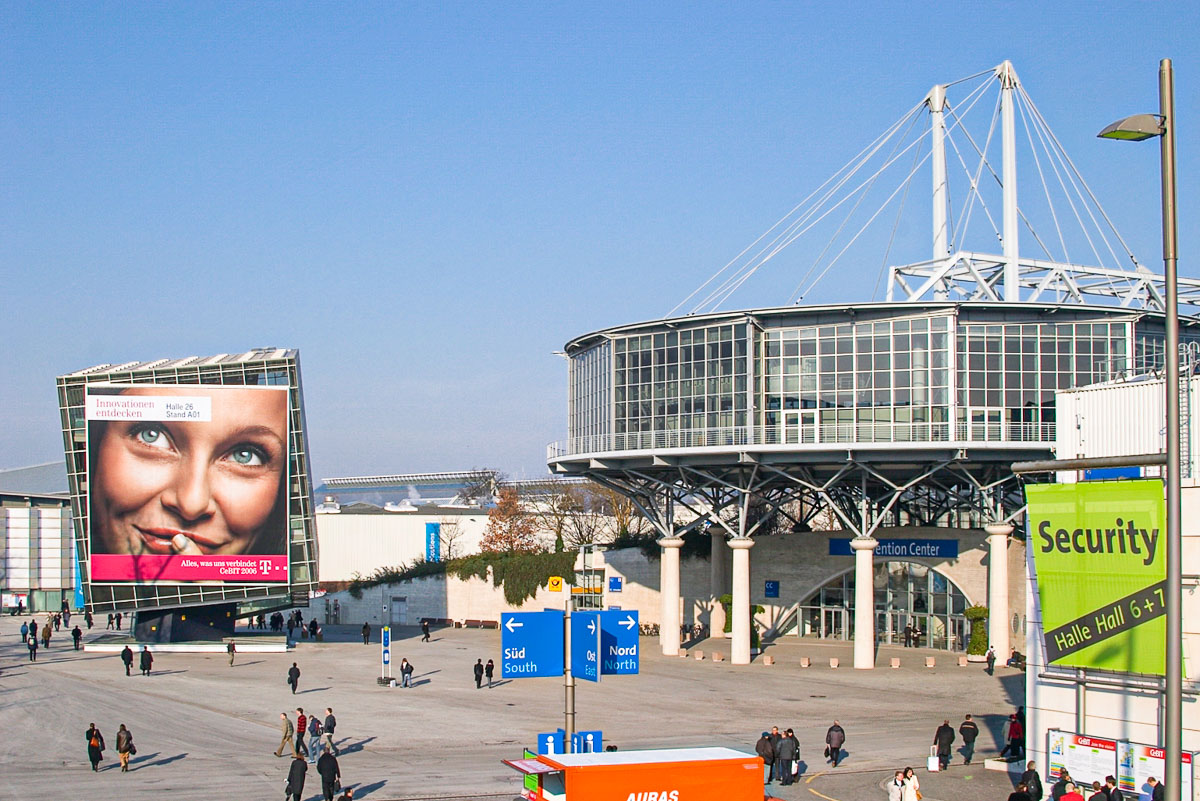
CeBIT – we loved it to bits! It was just sooo new and different and massive and…
The year was 1992. The Soviet Union had only just ceased to exist, but daily life was still pretty much ‘Soviet’, and things were real unstable for ordinary folks. Things were pretty chaotic and shocking too; example: Royal Spirit was being sold in the kiosks (newly imported from the Netherlands; never originally intended for drinking, but given the huge new market (unfettered by consumer protection laws) for strong spirits of questionable quality opening up to the East, they found a way; alas, not without victims – with folks poisoned, even dying after drinking it). And we’d come from that place of unstable chaos and found ourselves in stable, ordered decadent Germany, with centuries of uninterrupted capitalism and consumerism under its belt.
Like I wrote in part three – it truly was a cultural shock. But after a week of relative comfort in the West, we kinda got used to it. But then there was a second cultural shock – when we returned to Moscow! The differences, then, hit us all the more. But of course they would: the differences were all too real; example: family and close friends gave us tinned preserves, smoked sausage, and other such staples to take with us on our business trip – so that we could save our Deutsche Marks (this was long before the Euro:) by not spending them on sustenance, but better buying some kinda tape player to bring home, or some fancy clothing like a good pair of Levi’s or something. Recalling all this now, which was almost a way-of-life back then, you sometimes can’t quite believe it was real. The world today – it’s as if it’s another planet, with a wholly different civilization living on it!
Ok, cultural shock: done. But how come we found ourselves – so soon after the birth of the ‘Russian Federation’ – to be at CeBIT in the first place? After all, we weren’t even a company yet, never mind a globetrotting, leading-exhibition-visiting one. And the country was only just getting to its feet too. Well, there’s a story to this one, as told to me quite recently by Alexey Remizov, my former boss at KAMI, where I first worked (now I-Teco)…
It goes like this: Having departed to its next life, the USSR took with it many a Soviet ministry and committee, so new – Russian – ones needed to be created in their place. One such newbie, formed right before our CeBIT trip, was the Committee for Infomatization of the Ministry of Communications, which swiftly came up with the idea of having a joint stand at CeBIT with several Russian IT companies on it – including KAMI, where I’d been working since May 1991. Literally just weeks later, there we were in Hanover at the mega international exhibition – for a full week, showing off our various tech-wares, wide-eyed, taking it all in. Yes, it was a strange spectacle for us. But I’m sure not as strange as was the spectacle for visitors and other participants of CeBIT looking at the Russian delegation! Oh, and I was just about to write there ‘delegation of Russian startups’; however, the companies could never really have been accurately described so: back then investing in the Russian IT segment practically didn’t exist.
So, there we were – in CeBIT…
I touched upon this before in part three, but here are a few more details about… the MASSIVE size of the exhibition. It was housed in a full dozen or more humungous halls, there were thousands of stands of companies from all over the world, and hundreds of thousands of visitors (nearly a million at its peak). It was the biggest computer exhibition in the world – by far: much bigger than the number-two, COMDEX, in Vegas. The spectacle would have been fairly mind-blowing for a seasoned westerner working in computers for years. For us… mind-imploding! (I mean, I’d been to a few computer exhibitions in Moscow – Comtek, for example, in 1990 – but that was tiny by comparison).
But it wasn’t just folks like us – working within the industry the exhibition was promoting – who turned up at CeBIT. There were pensioners, children… most anyone – all there to get a glimpse of the action, and a few free pens, pads and other promotional knick-knacks (‘vacuum cleaners’, we’d call them – because they Hoovered up practically anything that wasn’t bolted down!). After all, this was the future – and it was so bright everyone had to wear shades. Not like today when we’re so used to tech getting better and bigger and faster and all the more extraordinary, like – every hour.
For example, I remember there was the world’s first every proper glimpse of the world’s first ever – black and white! – digital camera! The quality of the pics it took was so bad it was laughable by today’s standards, and it cost a pretty penny too (I recall $1000). They’d take a photo of some volunteers, transfer the pic to a screen connected to a primitive graphics editor, and they’d switch the heads of those volunteers, to whoops and applause of the huge audience!
There was a stand of an international IT corporation with a Formula-1 racing car on it (actually, not much has changed there, but back then it was a novelty:). There was a mannequin pouring coffee over a computer keyboard all day to demonstrate the game-changing benefits of a plastic waterproof keyboard covering. There was a hall dedicated to startups showing off all manner of Christs on bicycles… and it was all here, for a whole week.
Btw, this was in the spring of 1992 – pre-internet as we know it today (the first ever webpage had appeared less than a year earlier), and years ahead of the dot-com bubble.
It was all a lot of fun and games for the visitors, but for us it was nothing but hard slog: non-stop working the stand. And the result: none! No new customers, no prospects, zilch. Not that the trip was all in vain. It was our first step – and it made us realize we had to go back to Hanover in the future, which we did (after a few years – regularly), which led – in a round-about way – to where we are today.
But early on, yearly trips to CeBIT were out of the question: we had neither the time nor the money for such a thing. And anyway, we were certain further trips wouldn’t help develop our business, so, like, why bother? The few Russian software companies back then were treated skeptically viewed with amusement, then mostly ignored; hardly conducive to much that is useful.
But things started to change for us earlier than we first expected – in 1994…
As mentioned earlier, we won an antivirus test at the University of Hamburg. And by the spring of 1995 we’d already a dozen foreign partners (mostly in Europe). But what really gave us the push to another whole level was our second trip to CeBIT in the same spring of 1995. It was there and then we met the German company G-Data. It already had a long history in antivirus – in fact it had created one of the world’s first AV (in 1988 for Atari)! But it wasn’t too happy with its own antivirus engine and, seeing the results of the Hamburg contest, they wanted to talk to us about tech-cooperation. And that – to a large extent – was that ).
So, at CeBIT in 1995 we (not me in person, a colleague) first met the good folks at G-Data. At CeBIT in 1996 we (including me in person) signed a contract with the good folks at G-Data for its licensing of our AV engine and AV-database update system. But besides that important contract there wasn’t much really for me to do at CeBIT in the early years, so the next time I visited Hanover was in 2001. But from that year on, I went to every year up until 2012, and then another time in 2014, taking my total number of visits to 15.
Meanwhile, our presence every year at CeBIT was used for actively seeking – and finding – partners/distributors, mostly European. In 1999 we shared a stand with two other Russian companies, and in the year 2000 we had a stand all to ourselves – albeit in a far corner of one of the halls. In 2001 we’d inched toward the center – with our stand becoming a two-story one (albeit next to the public conveniences:). Thereafter, every year we edged nearer and nearer the very center of the hall – where all the action’s at; and finally – we made it to Antivirus Avenue, CeBIT, Hannover, with all our colleagues-competitors.
Why such a long time getting to where we should be – into premium real estate? Well, the organizers of CeBIT would always offer a company the spot it occupied the previous year, and the only chance of being allotted another one was if a company left their customary stand space allotment – when it would be offered to the other companies. Thus, in 2007, for some unknown reason, our very yellow competitor decided not to take part in CeBIT, so we jumped at the chance of taking their place – in the best spot on the whole ‘avenue’ ).
This is us on the joint stand with the two other Russian companies in 1999. ‘Cutting-edge technologies for enterprises’ – sounds confident, solid. What it really meant was ‘we’re desperate, we really need to sell stuff to get by!’
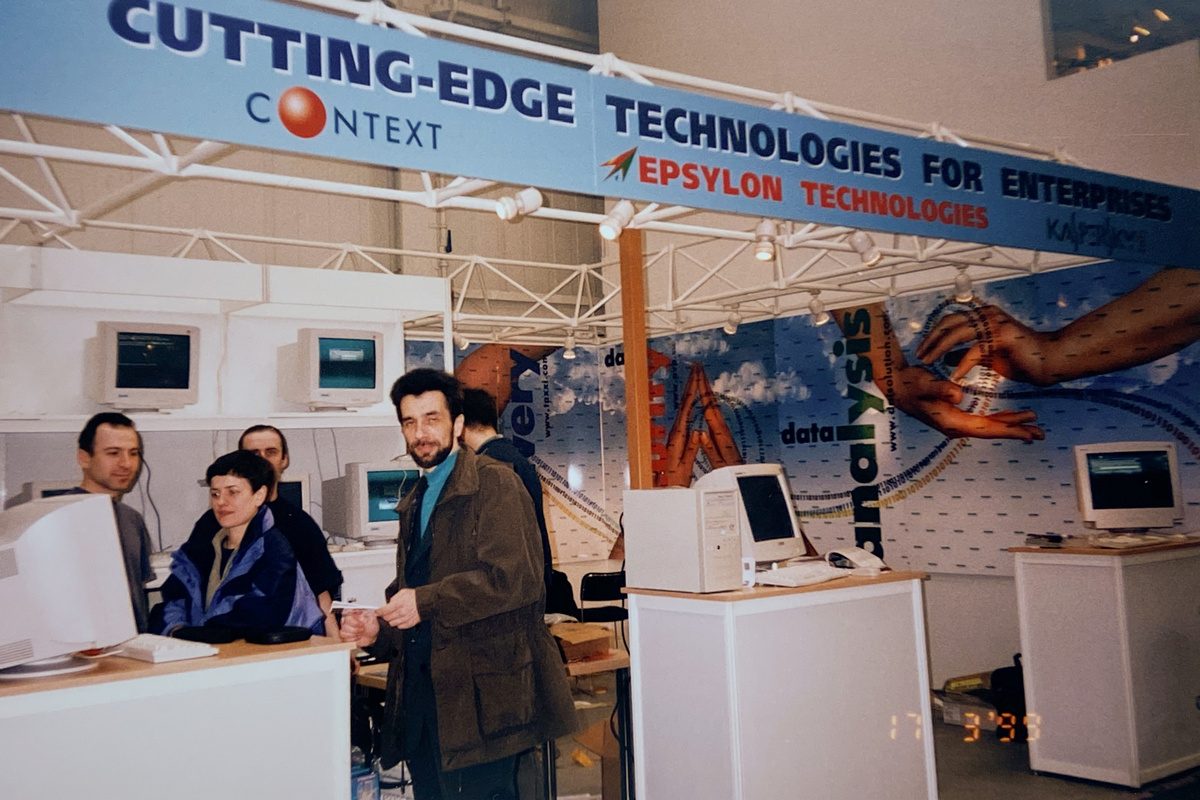
Our 2000 stand – in a corner:
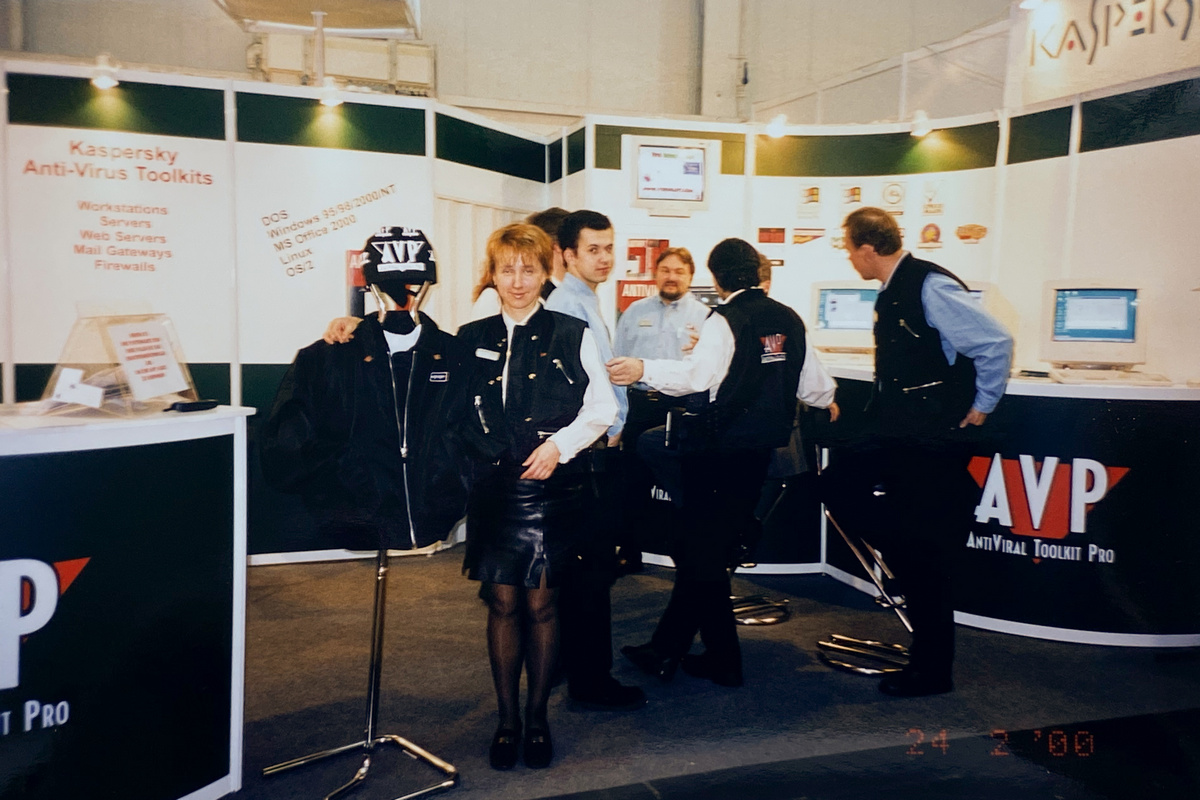
2001 – double decker! ->

See – it was right next to the bathrooms!
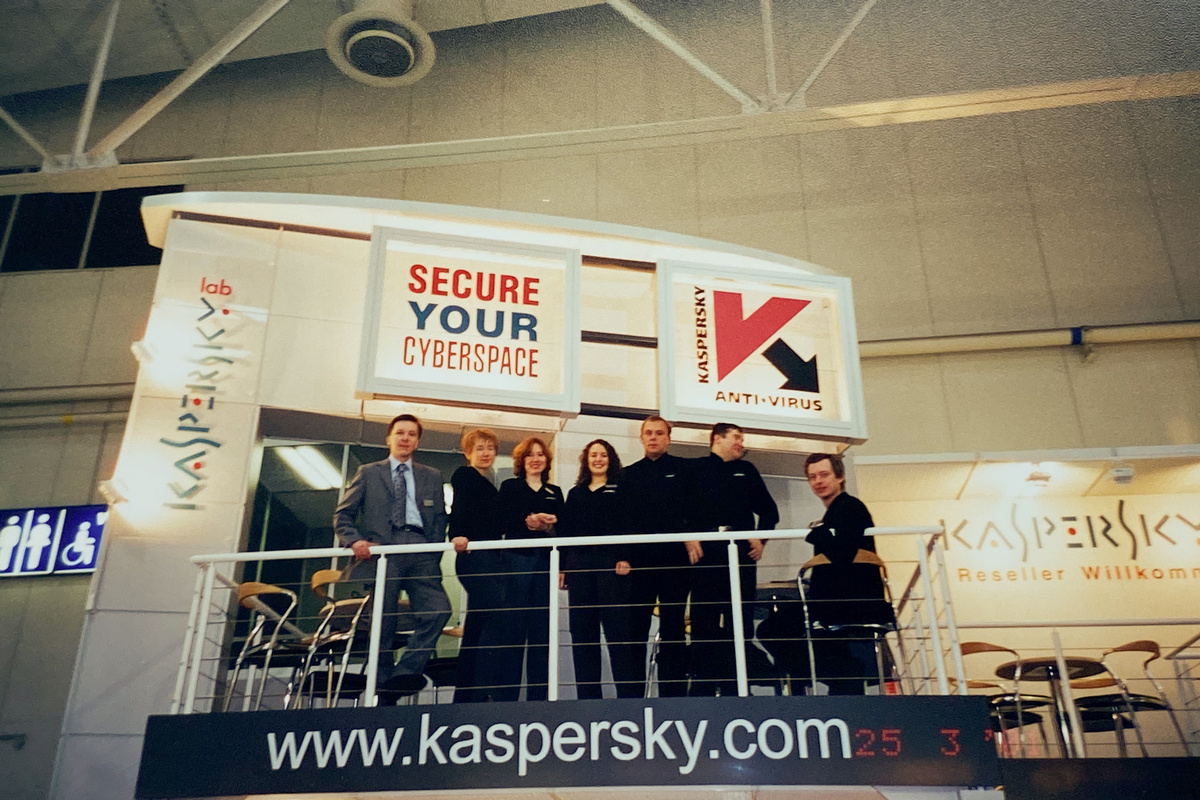
And here’s me, getting my hands dirty – literally:
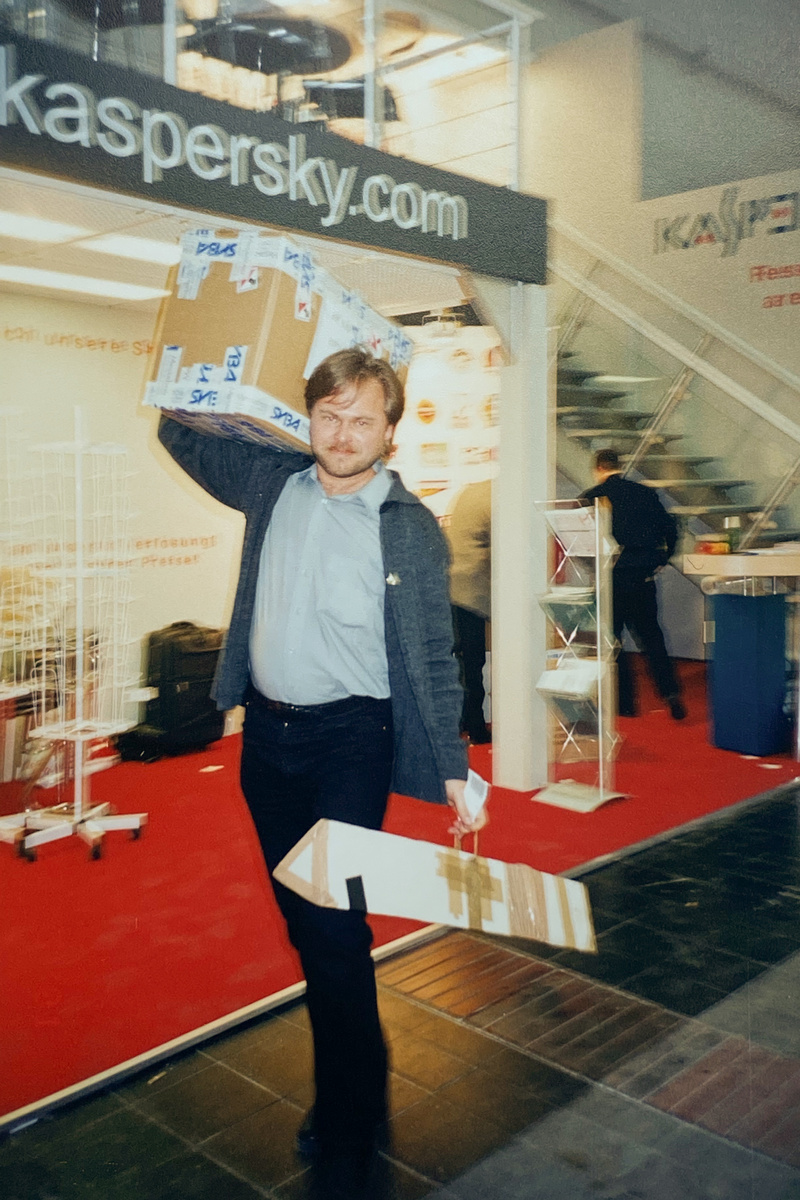
Fast-forward to 2008 – a marked improvement:
Now for a spot of the daily-mundane…
Any exhibition that calls itself serious… you kinda expect it to be located somewhere where there are plenty of hotels. Right? Right. But in Hanover, yep – you guessed it, there is (maybe – was; not sure) a catastrophic lack of hotel rooms. WHAT?!
The world’s best and largest annual international IT exhibition… took place in a city with hardly any hotels. Participants had to rent out apartments some 30, 50, 100 kilometers – sometimes even further! – from the exhibition complex. WHY? And this isn’t one of those general knowledge questions that I’ll surprise you with with my answer. For I don’t know the answer either.
But it did lead to some interesting, almost absurd, ways of making up for the deficit. Locals who lived in the city – or near it – would move out of their homes for the duration of exhibitions, preferring to rent those homes out to exhibition visitors (like a proto-Airbnb). Some didn’t move ‘out’ though; they moved ‘down below’ – into their basements (if their property had one)! And with the rent money saved after a few years – they’d build a house next door and start renting that out too!
Or maybe this strange situation re the lodgings imbalance occurred only for CeBIT? Maybe there were plenty places to stay during a ‘normal sized’ exhibition, which CeBIT certainly wasn’t. Maybe. I have been in Hanover for a different exhibition a couple times – Hannover Messe – and there were no probs with finding a hotel room in the city either time.
Ah – and while I’m on about unexplained weirdnesses of Hannover, I need to tell you of another I’ve just recalled: the situation at the city’s airport. Sometimes there can be lines hours long at passport control! What? But, this is Germany?! After two or three times suffering such awful lines, we decided to stop flying direct to Hanover, instead opting for nearby Hamburg of Frankfurt. But, like, again: ‘Hanover – please get a grip!’ :).
Here’s another thing I’ve just remembered. Not a criticism of Hanover, just of my imperfect memory. The exhibition center has an enormous parking lot covering about the same area as the enormous exhibition halls themselves. Well, once, I arrived in a rental car I’d just picked up, must have been in a hurry something, and parked up and off I popped. Come evening – I’d forgotten where I’d parked it and also what color it was! Thank goodness this wasn’t the 80s before beeper key thingies. Still – I was a good half-hour walking around that darn massive parking lot pressing my electronic keyfob until I heard a ‘beep, beep’; grrrr ).
But I digress. Back to our early CeBIT experiences…
Like I say, early on there wasn’t a great deal for me – on paper, a techie guy – to do at CeBIT. Negotiating contracts with distributors, discussing commercial conditions… – nope: none of that’s for me. But then we started to get more and more well known, and with fame comes… the press. And before you could say ‘press officer, but I never planned on being one’, my media activity went crazy: around a dozen interviews per day! All week! And with no lunch (a colleague always seemed to manage to add an extra, unplanned interview for that free half-hour in the middle of the day:). Come evening I’d be exhausted. All the others would go off to some nice traditional German restaurant (post-CeBIT bash – see below), while I’d just get back to my hotel room rented apartment room and zonk after a quick wurst from a kiosk or some such. Twice I recall I’d spoken so much all day with press that I got blisters on my tongue. Literally! )
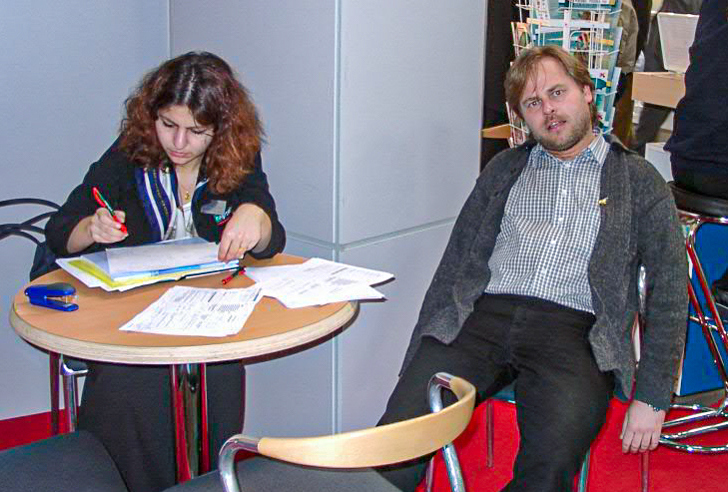
It was only years later that I asked myself the question – why did the press take such much of an interest in us?
I think it’s because ‘cybersecurity’ back then was a very hot topic (interestingly, curiously, just like today!), with attention to it growing quickly. And out of all the stands at CeBIT there was only one – ours – able to talk about it at length from a true expert’s standpoint. Others were limited to the typical bright and shiny product/marketing hypnotism, but folks were tired of all that already (that was 20 years ago; some are still at it today. Go figure:). Whereas we were able to recount stories about cybercriminals, how and why they hack into their victims’ computers and networks, what they pilfer, and how they can turn what they pilfer into hard currency. And it appears that, against a backdrop of traditional marketing BS from our competitors, we came across rather fresh, untraditional, interesting: just what the press likes ).
A few more pics. Fast forward to CeBIT in 2010:
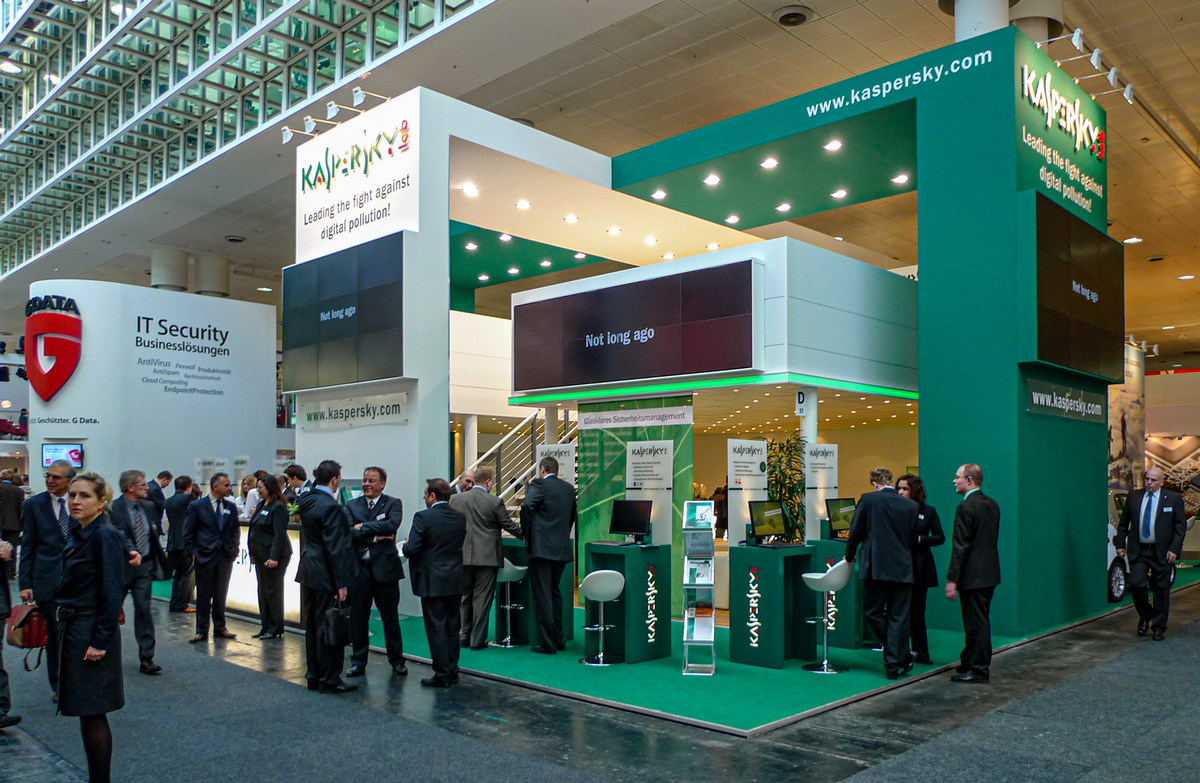
And here’s ‘Antivirus Avenue’. Trend Micro, G-Data, Avira and more. The organizers divided the floor space as per different industry segments. This pavilion was given over to all sorts of cybersecurity companies, including us. But, come 2010, the list of participants of AV companies grew shorter. Symantec, McAfee, F-Secure and other smaller companies all stopped coming to the annual bash. Meanwhile, we were getting bigger and brighter (but always based on the expertise:) every year!
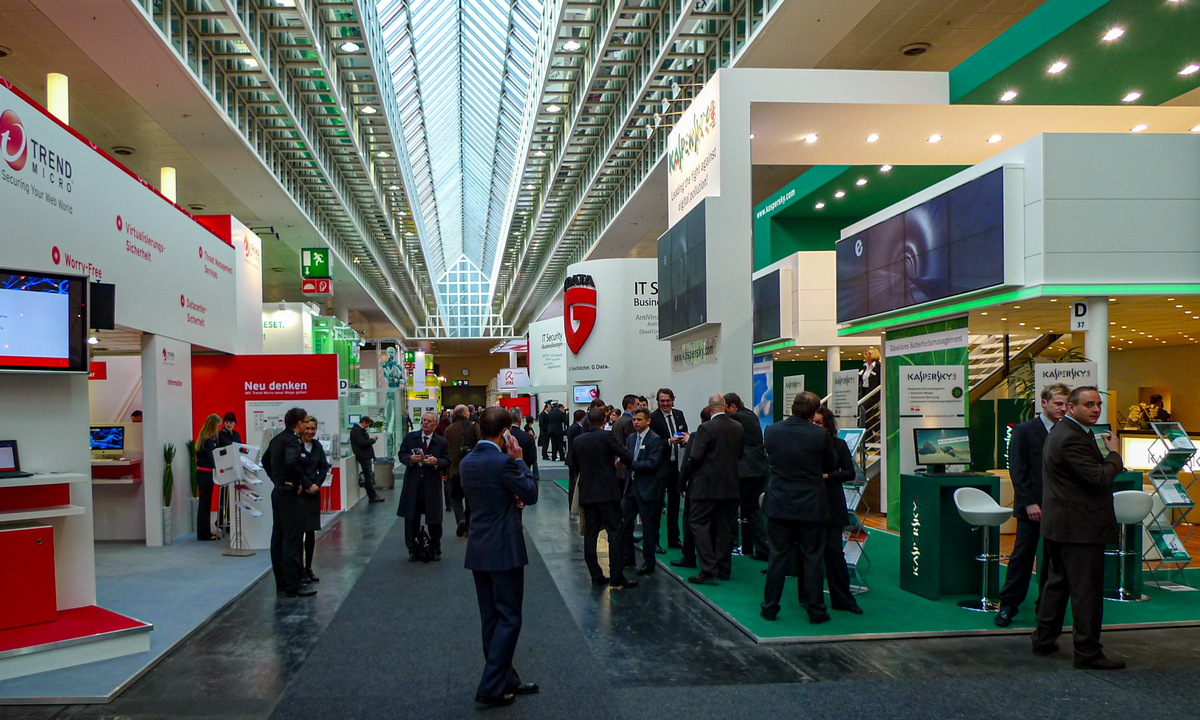
Some years I’d arrive on the eve of the opening of the exhibition – when the stands were still being set up:
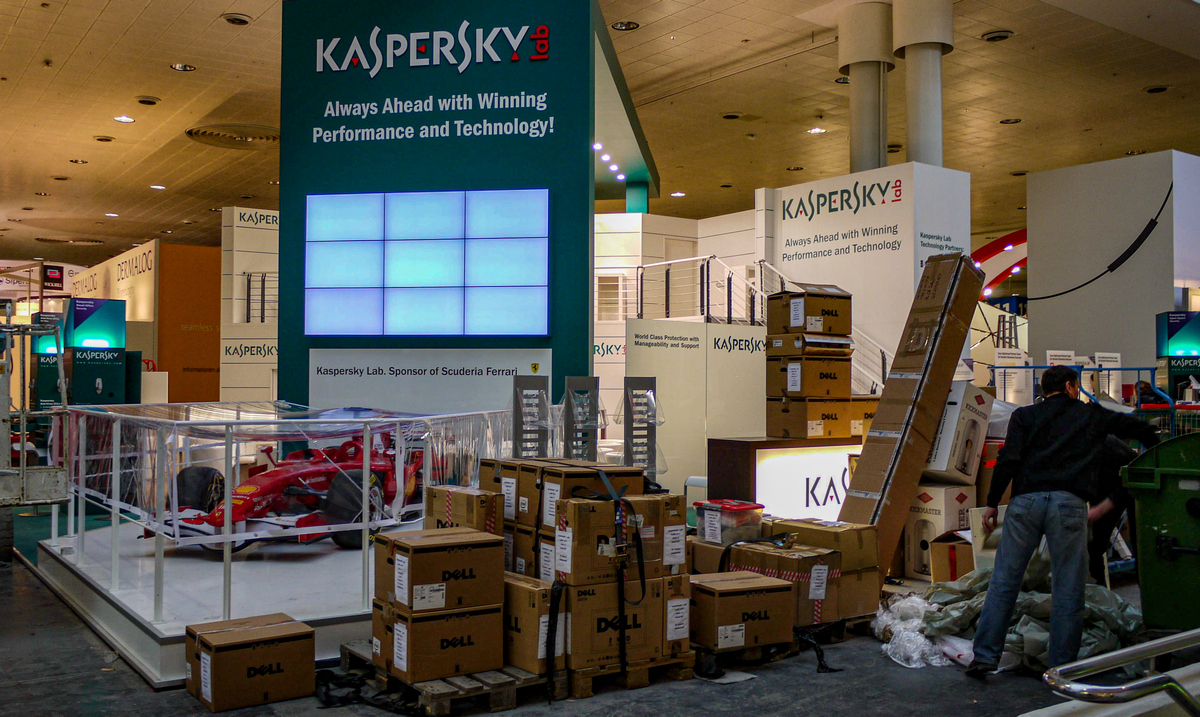
Here’s our stand in 2012, all set up and ready to go:
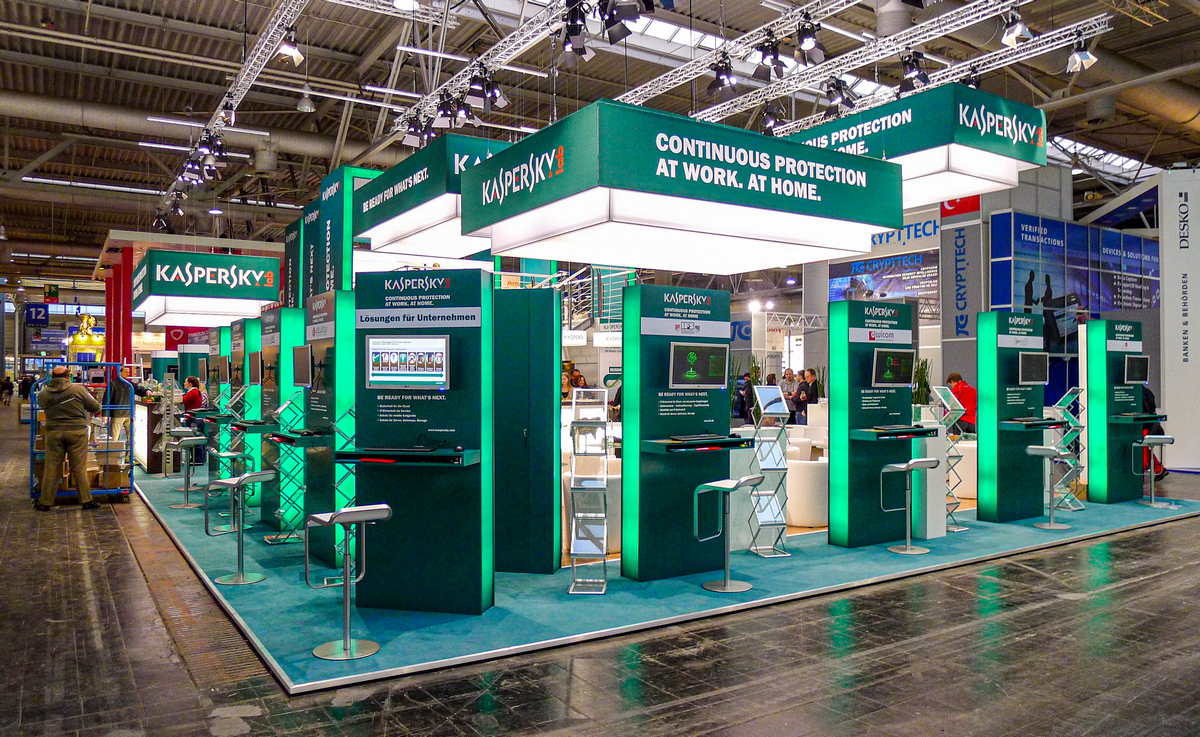
…And here’s that same stand the day after – day one of the exhibition: non-stop bustle. For me: non-stop interviews with internet, TV, radio, newspaper and magazine journalists, meetings with our business partners, meeting with new business partners for the first time – and no lunch :(.
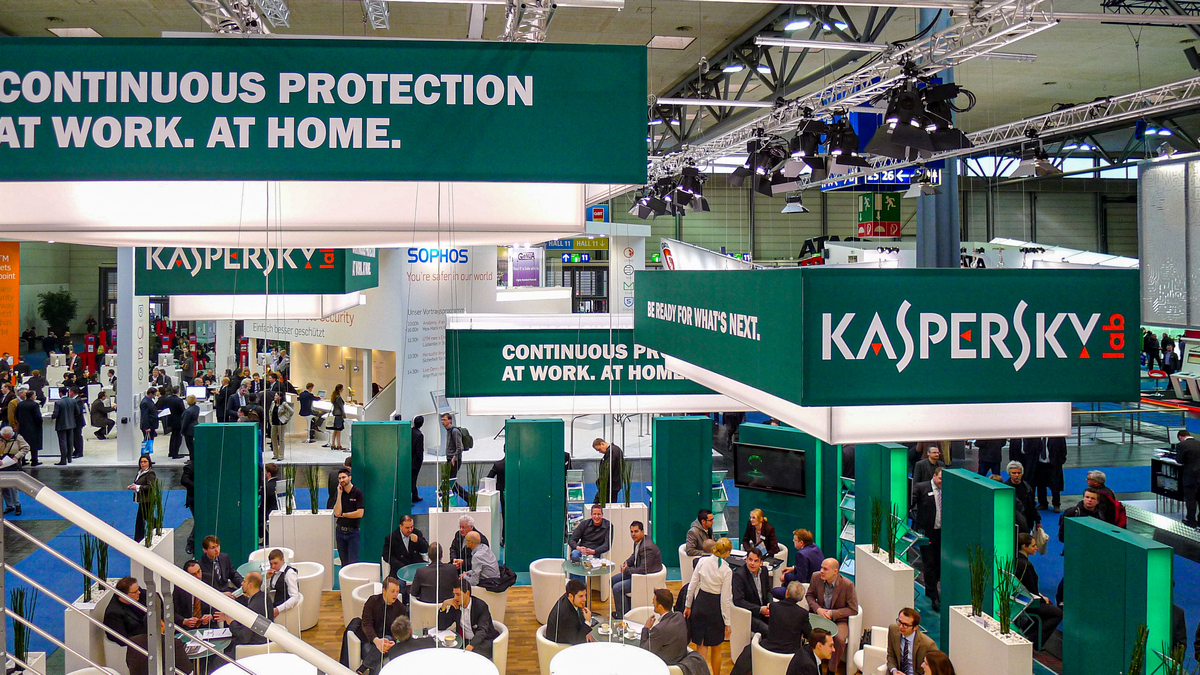
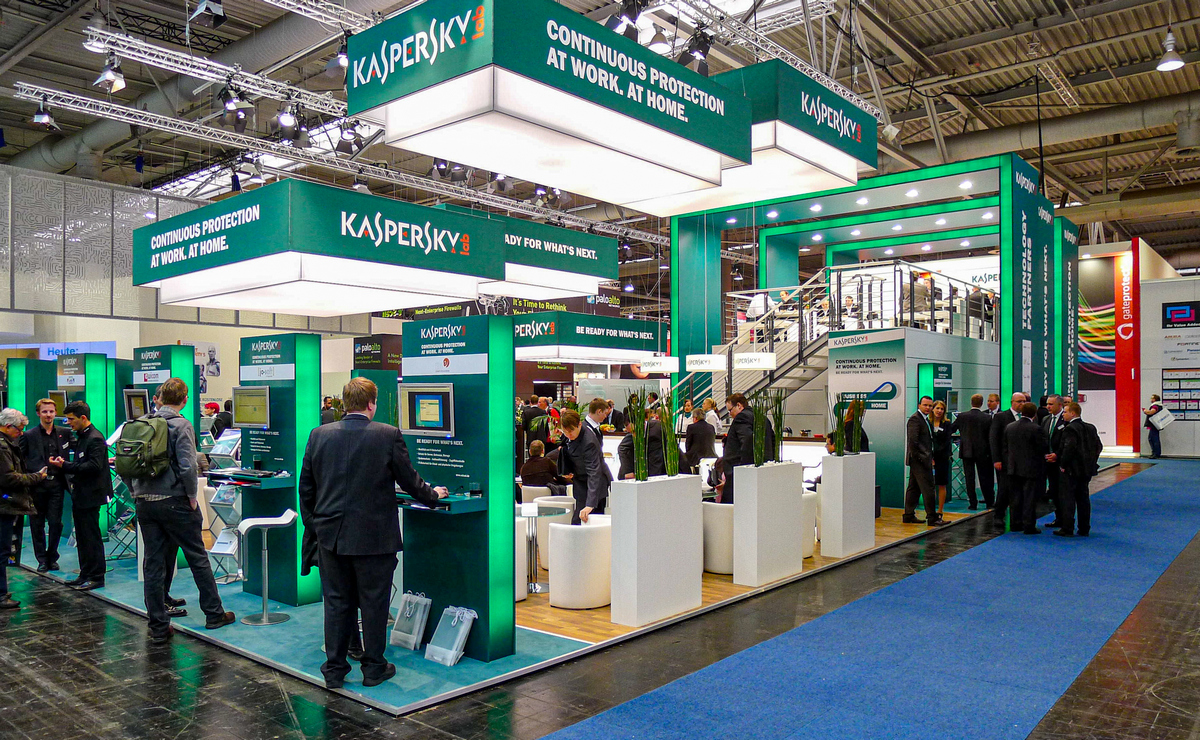
Here’s our lounge area – always full. Sometimes I’d use it as an ad-hoc mini-conference hall to talk to different distributors and resellers from all over the world. Well, they were all here, so why not tell them about our news, plans, new product ideas all together? Then, just maybe, I’ll have time to grab some lunch for once ).
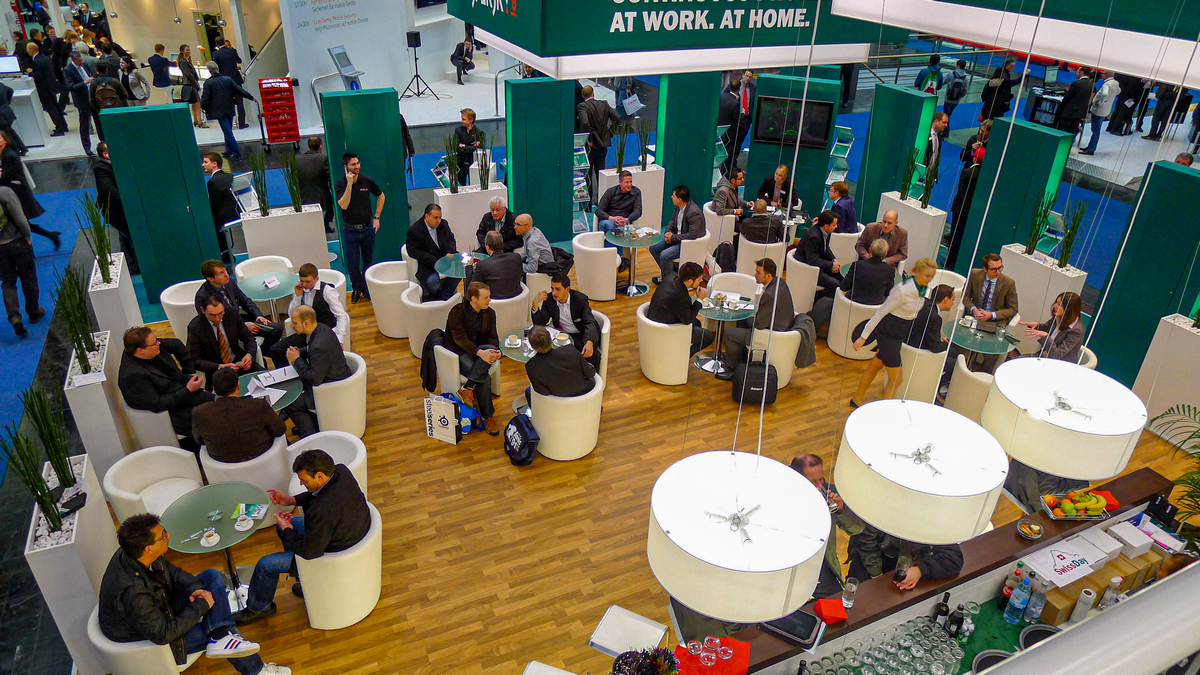
Since our stand was quite large we had a few dozen employees working on it. And those employees – and of course our guests/partners – needed feeding and watering regularly. Accordingly – we had our own mini-café. This is the place I, regrettably, spent far too little time in ).
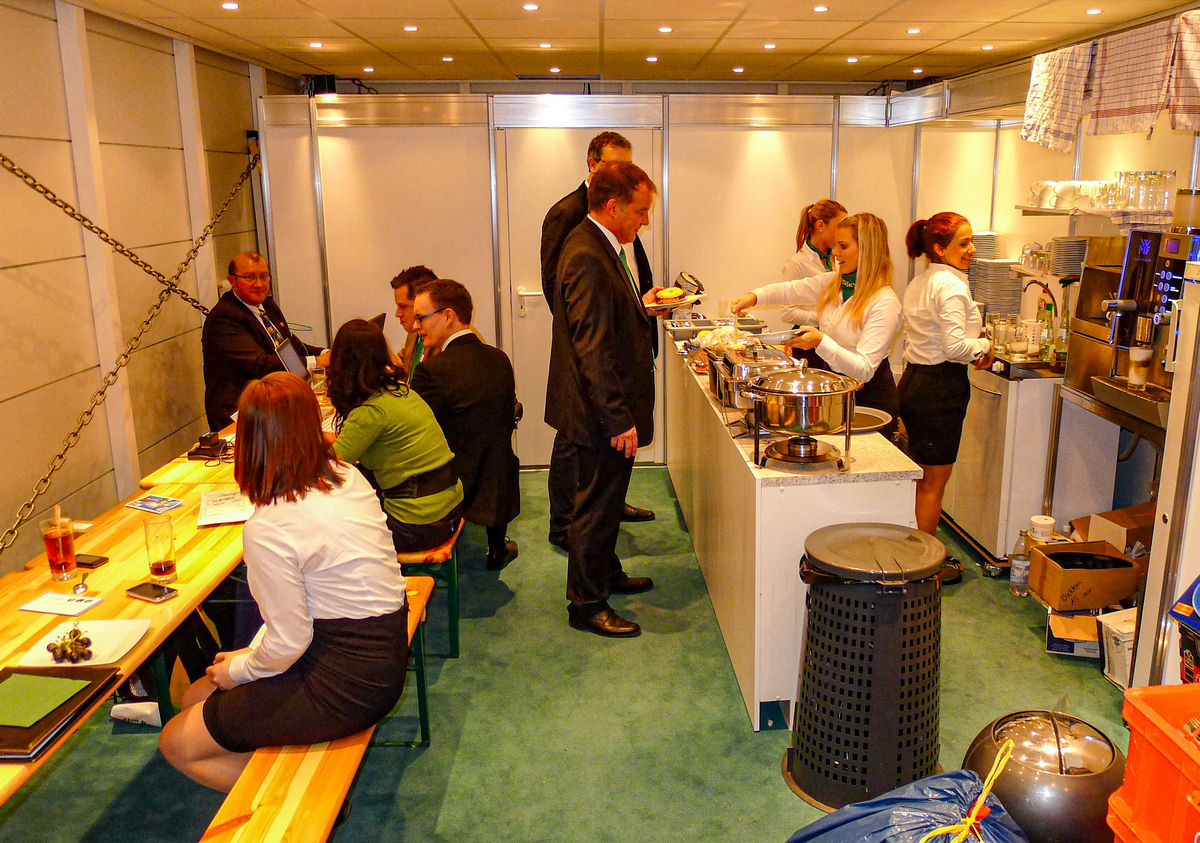
Come evening… (you might not believe it): party! Beers, DJs, disco, dancing, merriment; hair: down.
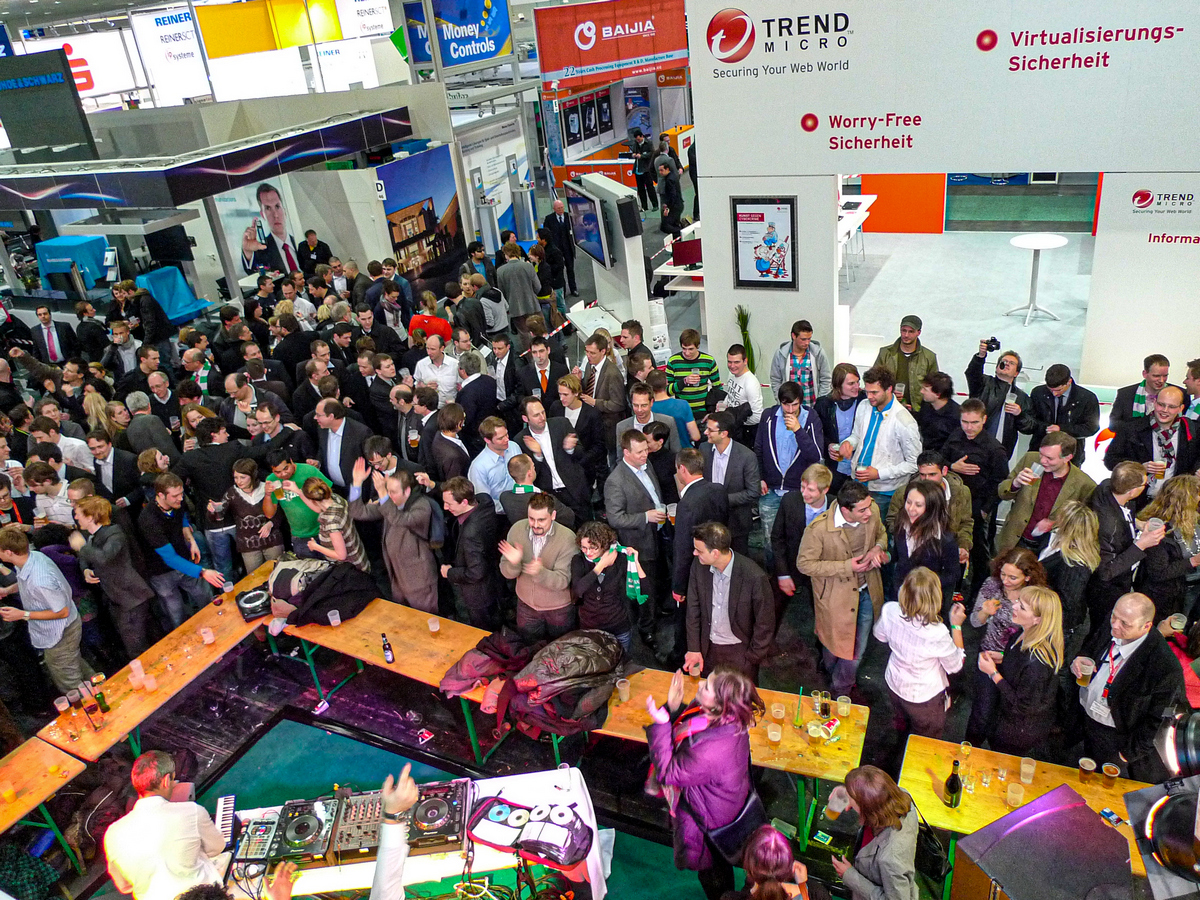
One of the many great things about CeBIT was that it would have some fun after the days’ hard work was done. It was like this: each self-respecting company would take a turn to put on one evening of partying on its stand – so that’s one party per night for the whole week! And there were no rules as to the format for an evening do. Well, here’s our allotted party night:
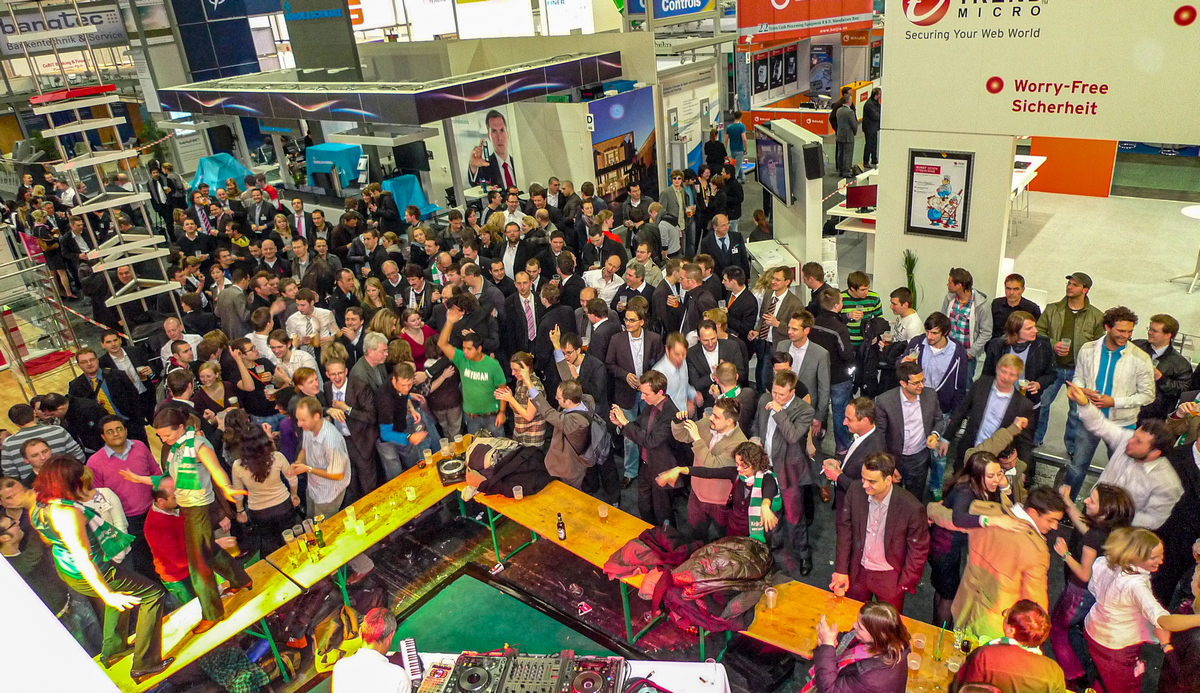
Yes – that is two ladies dancing on the tables :).
A few times we invited some Russian expat DJs living in Berlin to spin some ‘Russen Disko’ tunes:
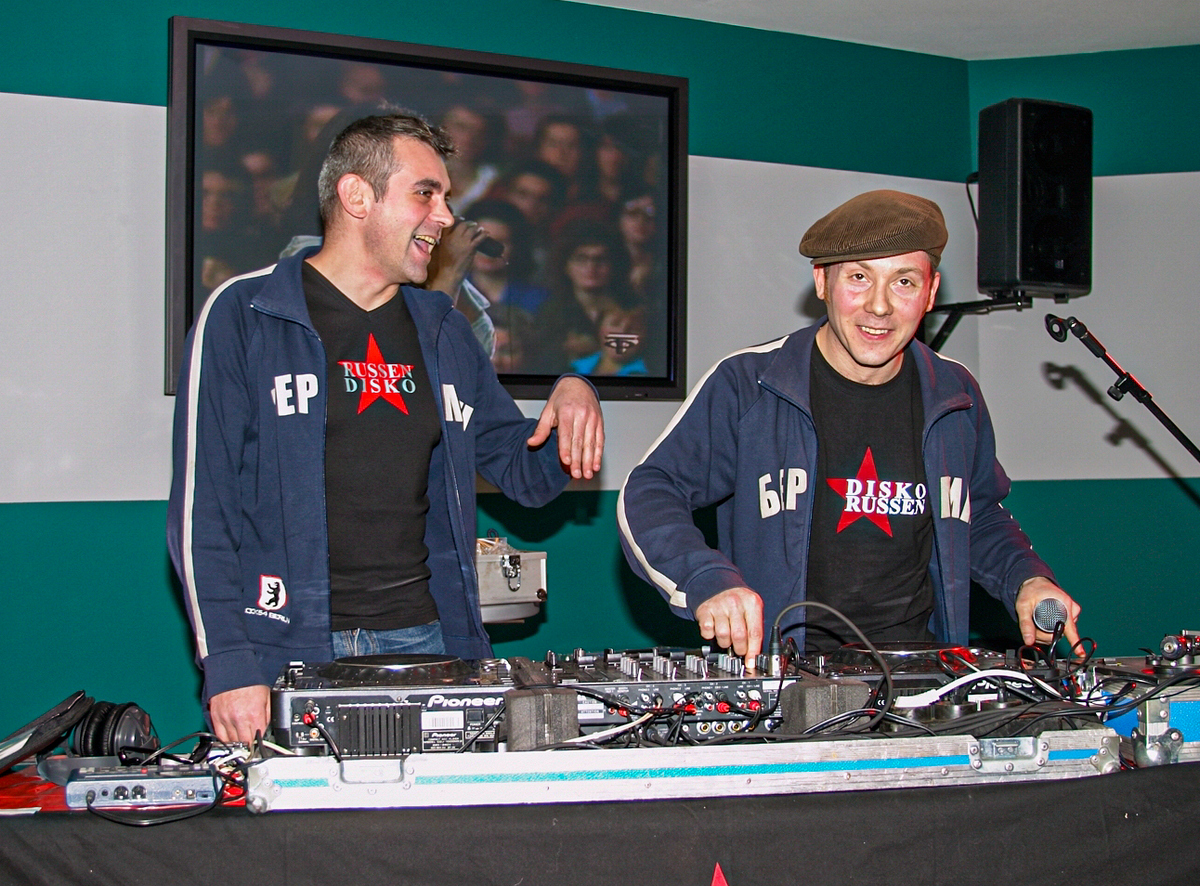
Ok, the music wasn’t all Russian (we didn’t want to overdo it:), but the cartoons up on the screens sure were Soviet. The dancing and drinking would go on for hours, making our night among the busiest. The best too, according to the local Messe Zeitung exhibition magazine: awarding our night ‘the coolest party of the whole of CeBIT’! Alas, no copy of that magazine issue has survived.
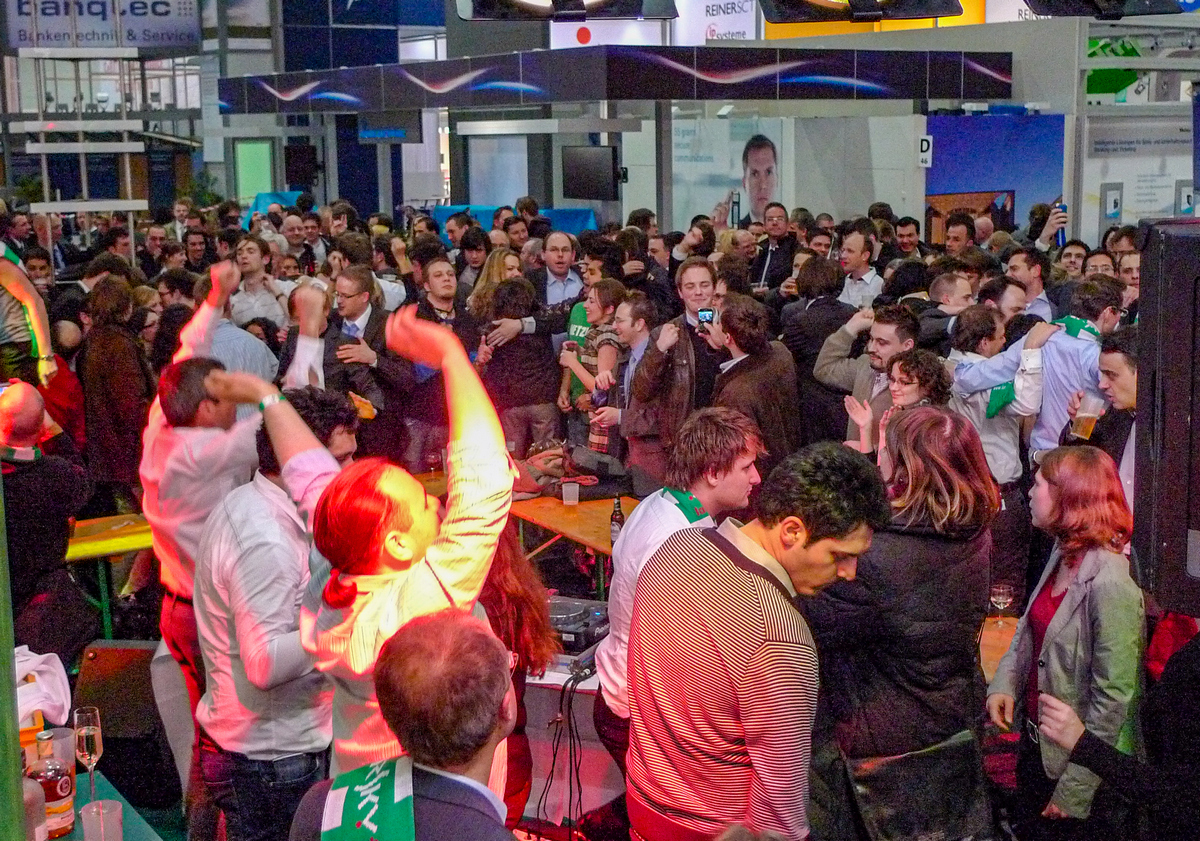
I don’t think there’s another exhibition – even an IT one – I’ve been to besides CeBIT that permitted such a relaxed format in the evenings. The industrial Hannover Messe, for example, which takes place in the same complex, is very much a ‘shirt and tie’ event: absolutely no shenanigans of an evening :). Even Barcelona’s Mobile World Congress – which is similarly bright, fun and dynamic like CeBIT… – no horseplay whatsoever!
And finally, to finish – alas – I play a decidedly minor chord…
Come the early 2010s, CeBIT, despite its format having worked just fine for decades, decided to change its format. It became more German-specific-oriented, more businessy, more formal. As a result, practically the whole of the Asian contingent CeBIT stopped coming.
It was all downhill from there. All things mobile seemed to switch to MWC in Barcelona and other Asian trade shows, and that was it – eventually: game over. CeBIT finally ceased to exist in 2019 :(.
My last CeBIT was in 2014. Only three antivirus companies were there: us, Sophos and ESET (just to compare – at its peak (2000–2005) there were around a dozen).
But for my last time I was there for a different reason:
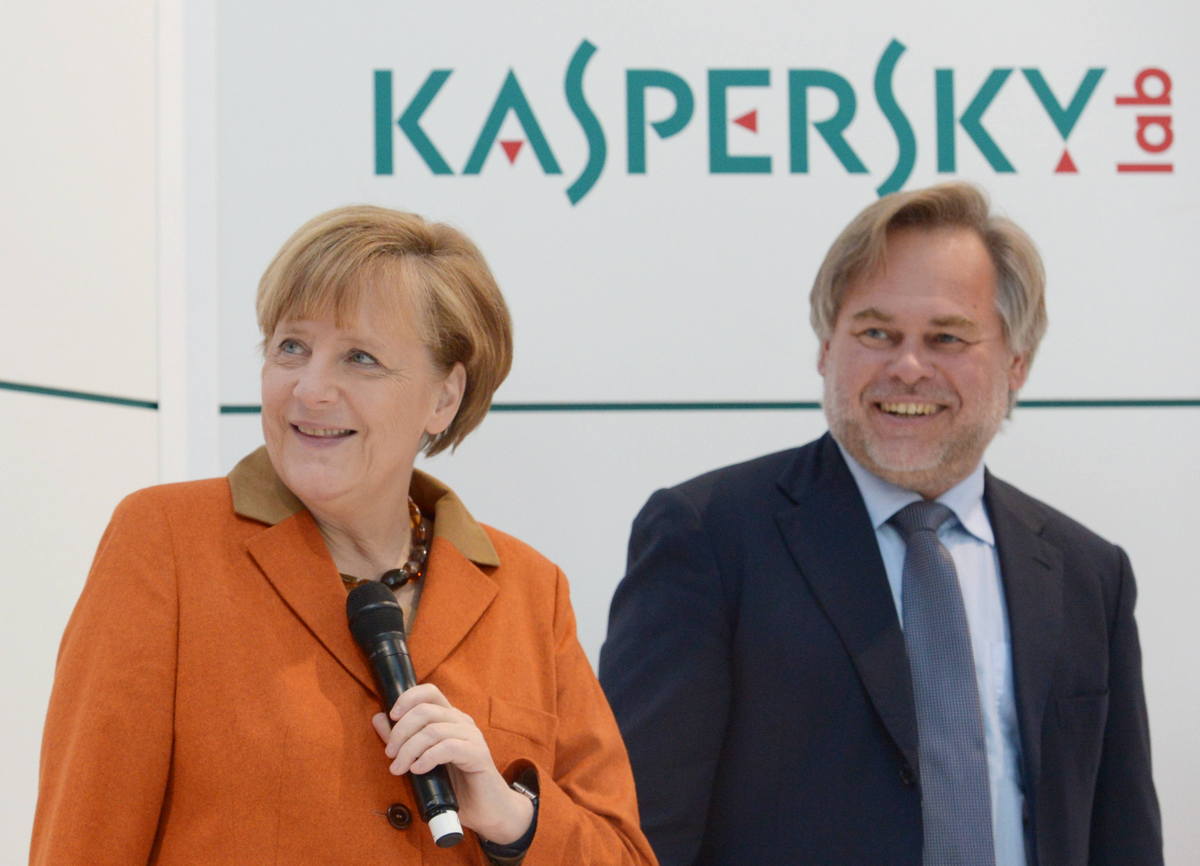
I think the photo says it all. Just in case – details: here.
PS: You may be wondering why I’ve written so much about a single annual IT exhibition.
Well, actually, it’s because I consider CeBIT to have been so crucial to our development. Our continual presence there was one of the key factors to our success – especially in Europe. For it was there where every year there’d be an extraordinarily high concentration of useful contacts and IT press, and there where we could shout proudly about how we’re better than our competitors – and folks would take notice!
Also our ‘path to greatness’, trodden in a great part at CeBIT, is also now pretty much a historical study – very of its time. That’s another reason I wrote a lot: it kinda closes a significant chapter, so I had to do it properly. Today startups I’m sure don’t have to go through such bizarre teeth-cutting adventures. There are investors these days, and there are the lessons to be learned by looking at other, older companies’ experiences. Lucky them. Still – it was lucky us, too: that path to greatness much trodden at CeBIT, though often hard, sure was fun!…




